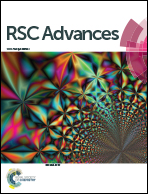Photobase generating monomers: synthesis, evaluation and utilization for fabricating fluorescence patterns
Abstract
In this study, we fabricated four new photobase generating monomers, in which carbamate units functioned as the photobase generating moieties, methacrylate units served as the polymerizable groups and four different groups, succinimido, camphorquinone 3-oximino, di-2-thienyl ketoximino and difuril dioximino units, acted as photosensitive species. The effect of different photosensitive species on the photochemical behavior of the monomers was investigated in detail. The results demonstrate that, among the four monomers, succinimido methacryloxyethyl carbamate (SMC) exhibits the most stable photobase generating property. Furthermore, a copolymer containing SMC is used for a fluorescence imaging material. The fluorescence spectrum of the fluorescamine-treated irradiated copolymer film showed a strong fluorescence in the range of 420–650 nm with a fluorescence maximum at 476 nm. The patterns in the copolymer films exhibit very distinct fluorescence images with colors of blue, green and red at certain observation wavelengths.


 Please wait while we load your content...
Please wait while we load your content...